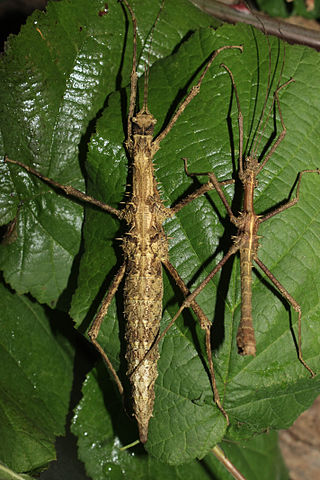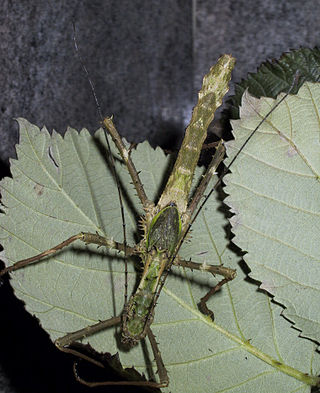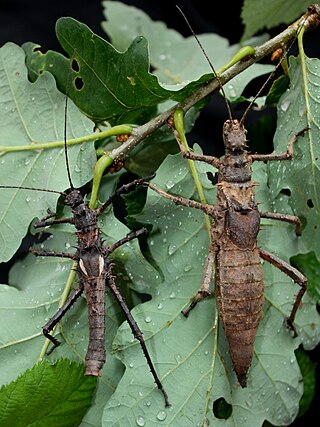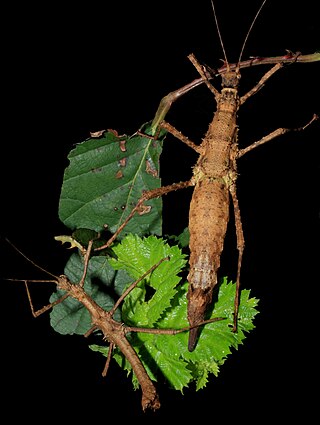
Heteropteryx is a monotypic genus of stick insects containing Heteropteryx dilatata as the only described species. and gives its name to the family of the Heteropterygidae. Their only species may be known as jungle nymph, Malaysian stick insect, Malaysian wood nymph, Malayan jungle nymph, or Malayan wood nymph and because of their size it is commonly kept in zoological institutions and private terrariums of insect lovers. It originates from the Malay Archipelago and is nocturnal.

The Heteropterygidae is a family of stick insects belonging to the suborder Euphasmatodea. Species can be found in Australasia, East and Southeast Asia. About 150 valid species have been described.

The genus Orestes combines relatively small and elongated Phasmatodea species from Southeast and East Asia.

Datamini is the only tribe within the subfamily of the Dataminae from the order of the Phasmatodea. The representatives of this subfamily are on average not as large as those of the other two subfamilies belonging to the family of Heteropterygidae.

Heteropterygini is the only tribe within the subfamily of the Heteropteryginae. With 19 representatives described, this subfamily includes the fewest species of the three subfamilies, but includes the largest and most striking species of the family.

The genus Dares, which is mainly native to Borneo, combines relatively small and mostly dark-colored Phasmatodea species.

The genus Planispectrum combines very small and compact species from Southeast Asia.

Hoploclonia is the only genus of the tribe Hoplocloniini and brings together relatively small and darkly coloured Phasmatodea species.

Aretaon is a genus of stick insects native to Borneo and the Philippine island Palawan.

Obrimus is a stick insect genus native to the Philippines. It is type genus for the tribe and the subfamily in which it is listed.

Orestes mouhotii is an insect species belonging to the order of Phasmatodea. Because of its synyonym Orestes verruculatus, it is the type species of the genus Orestes. Because of its compact body shape, the species is sometimes referred to as small cigar stick insect.

Aretaon muscosus is a stick insect species from the family Heteropterygidae, which is native to Borneo.

Trachyaretaon carmelae is a species of stick insects. It is one of the largest in the subfamily Obriminae.

Haaniella erringtoniae is a stick insect species. It is a typical representative of the subfamily Heteropteryginae. The occasionally used common name Errington's Haaniella refers to the species name.

Haaniella dehaanii is a stick insect species. It is a typical representative of the subfamily Heteropteryginae. The occasionally used common name De Haan's haaniella refers to the species name.

Trachyaretaon echinatus is the type species of the genus Trachyaretaon in the order of the stick insects.

Haaniella scabra is a species of stick insect native to Borneo and a typical representative of the subfamily Heteropteryginae. The occasionally used common name Small Haaniella refers to the size of this.

Brasidas cavernosus is a representative of the stick insects native to the Philippine island Luzon. It is considered one of the largest species in the subfamily Obriminae.

Brasidas lacerta is a species of stick insect in the family Heteropterygidae which is endemic to Mindanao. Due to its extreme variability, and the nymphs being spinier than to the adults, the species has been described under other names, resulting in a total of seven synonyms.

Haaniella echinata is a stick insect species that is native to the entire north of Borneo. After Haaniella scabra, it is the representative of the genus Haaniella that inhabits the highest biotopes on Borneo.

























